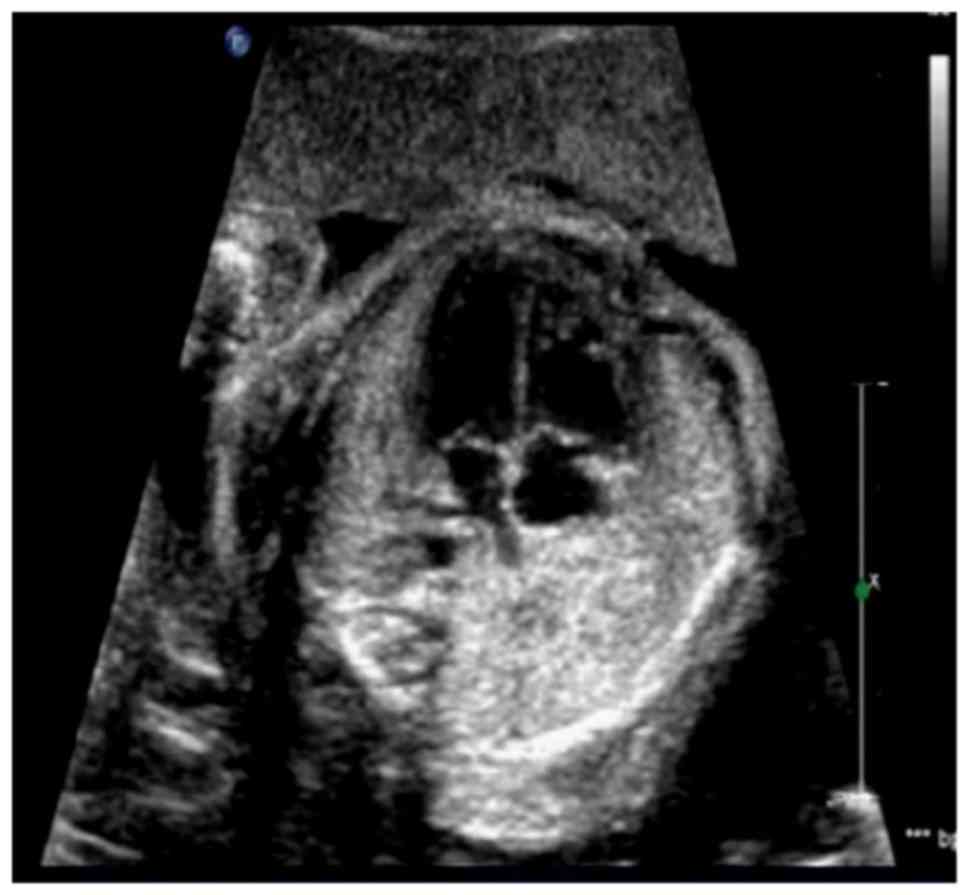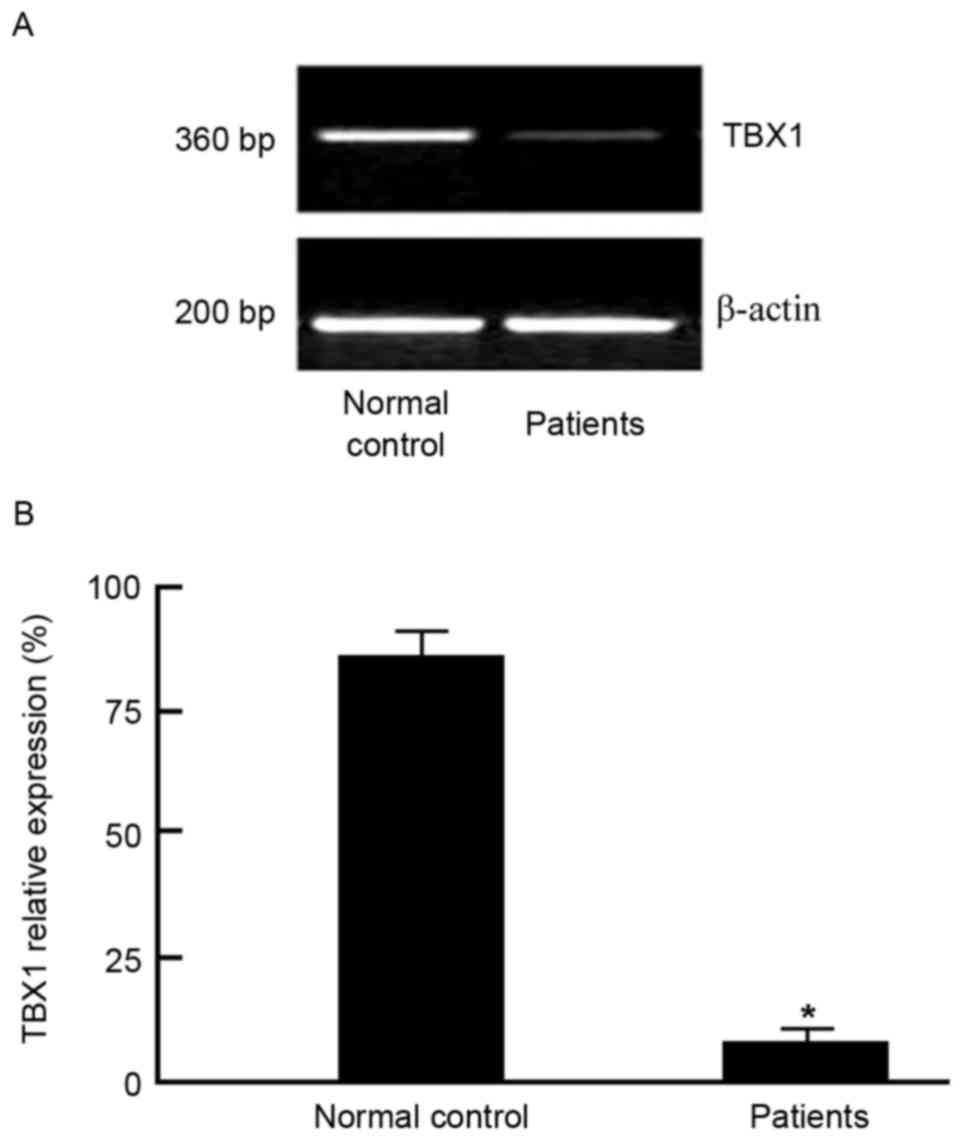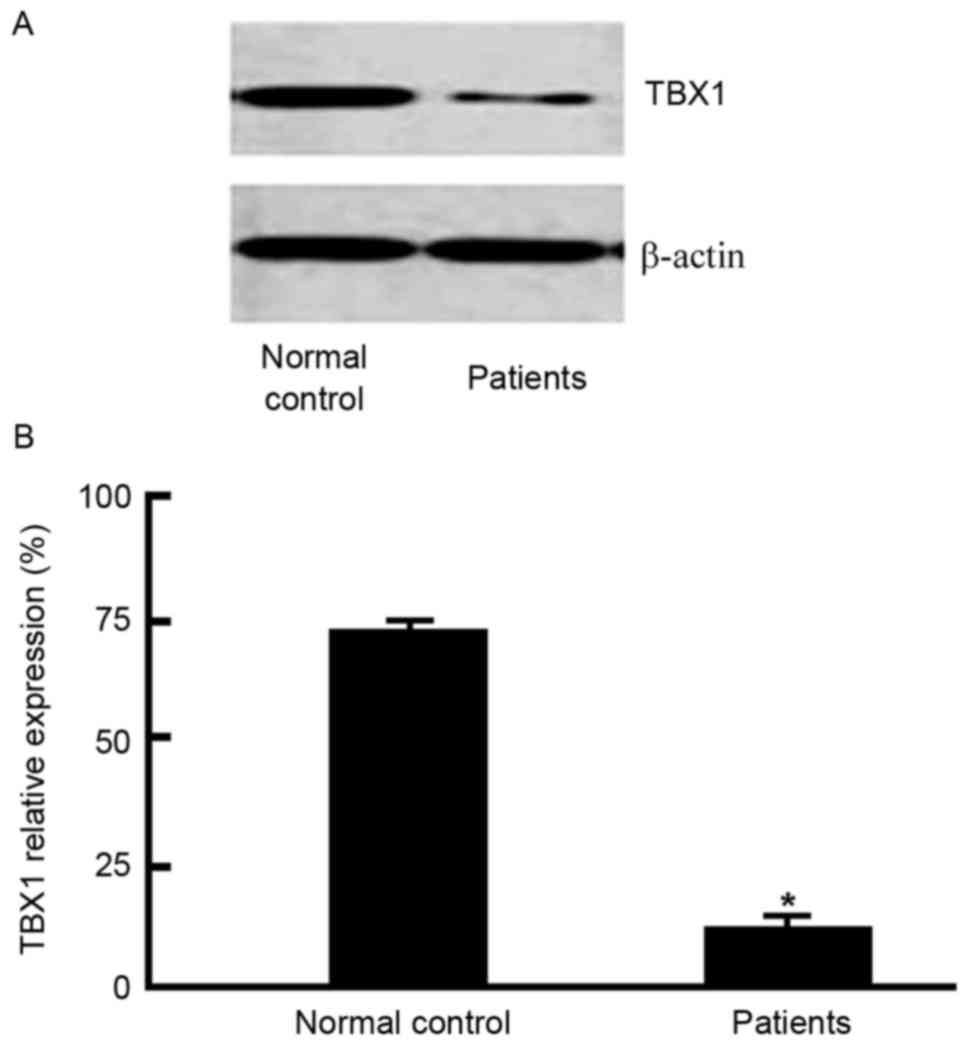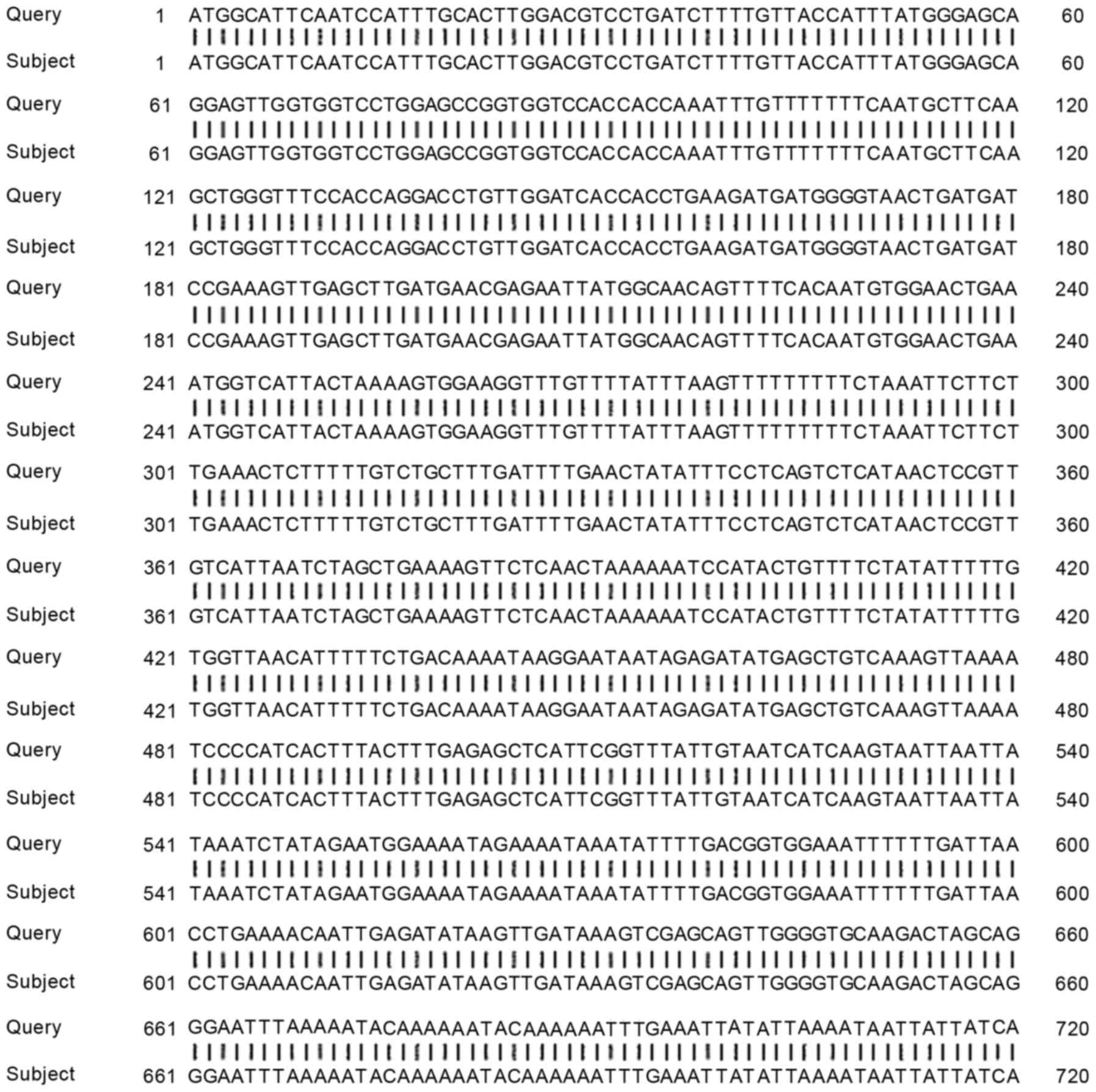Clinical study of prenatal ultrasonography combined with T‑box transcription factor 1 as a biomarker for the diagnosis of congenital heart disease
- Authors:
- Published online on: March 14, 2018 https://doi.org/10.3892/mmr.2018.8742
- Pages: 7346-7350
Abstract
Introduction
Fetal congenital heart disease (CHD) is a serious heart defect with high incidence (1). Its incidence is about 1–40/1,000 worldwide (2). In China, there ~300,000 fetuses with CHD (3), bringing a heavy burden to families and society (4). Therefore, prenatal detection of fetal malformation and elucidating the molecular mechanism of fetal CHD has important clinical significance and practical value (5). More importantly, prenatal examination also has great significance to reduce fetal CHD birth rate and promote prenatal and postnatal care (6).
Following science and technology developments, increasing methods for early fetal CHD diagnosis have been applied with high accuracy. Among them, color doppler ultrasound technique is one of the most important screening methods for detecting fetal CHD (1,7–9). With the improvement of ultrasonic detecting instrument resolution, color ultrasonic detection serves an important role in reducing fetal CHD incidence and mortality (8,10).
Laboratory testing methods, especially polymerase chain reaction, western blotting and gene sequencing, also have critical roles in fetal cardiac function screening. At present, laboratory testing methods have become an important supplement of ultrasonography for fetal CHD (11–13). Recent research suggested that the T-box transcription factor (TBX) family of proteins, especially TBX1, has a close association with fetal CHD occurrence and development (14,15). TBX1 is a transcription factor expressed in several tissues but its early expression in mesodermal tissue is particularly important for normal development of second heart field-derived heart segments, especially the outflow tract. Animal experiments have revealed that TBX1 overexpression is positively associated with CHD, indicating that TBX1 may be associated with fetal CHD occurrence (16–18). The aim of the present study was to investigate the clinical application value of prenatal ultrasonography combined with molecular biology methods in the diagnosis of fetal CHD.
Materials and methods
Experimental subjects
According to the inclusion and exclusion criteria (19,20), 1,000 cases of pregnant women who had received fetal ultrasonography between June 2012 and June 2015 in Jining No. 1 People's Hospital (Jining, China) were enrolled. The inclusion criteria consisted of pregnant women at 18–25 gestational weeks and aged 18–30 years old, with no CHD family history or other serious disease history. Exclusion criteria were the subjects unmatched to the inclusion criteria. All subjects and families were informed of the purpose of the study and signed informed consent was obtained. The present study was approved by the ethics committee of Jining No. 1 People's Hospital. Ultrasounds were performed at 18–25 gestational weeks. The mean age of pregnant women was 24.9±4.2 years.
Ultrasonography
A GE Voluson E6 color doppler ultrasonic detector at 6–10 MHz was used for fetal cardiac ultrasonography (21). Routine inspection (blood test) was applied before ultrasonography to test fetal development and position. Special examination (electrocardiogram and echocardiography) was then performed to test fetal heart. During color doppler ultrasonography, the pregnant women took a supine posture to reduce the probe pressure. Their posture was modulated to obtain the best imagine and different view angle. Ultrasound examination was conducted by the chief physician. Fetal heart position, size, structure, function, and heart valve morphology and function were examined. Fetal heart development condition was analyzed, including the right ventricular outflow tract, left ventricular outflow tract, pulmonary stenosis, atresia, aortic abnormalities, endocardial defects, valve deformity, cardiac neoplasm, tricuspid mobile and ventricular septal defects. Finally, aortic arch detects, tetralogy of Fallot, aortic stenosis, heterotopic heart, pericardial effusion and cardiothoracic ratio were examined. All pregnant women received fetal CHD screening and review in strict accordance with the world and domestic standards (22).
Prenatal intervention method
For the cases diagnosed as fetal CHD, subjects and their families were informed as soon as possible and accurately to decide on the following examination. Termination was proposed for the cases that were determined to be incurable (23). For the fetal CHD cases that progressed to induction of labor, the families agreed to scientific examination.
Pregnant women blood sample collection and analysis
For the cases with fetal CHD, 3 ml venous blood was extracted from the pregnant women with heparin anticoagulation (24). Genomic DNA was extracted using a DNA extraction kit (Thermo Fisher Scientific, Inc., Waltham, MA, USA) according to the manufacturer's protocol.
PCR
PCR was applied to test whether fetal CHD was associated with TBX1 (25). TBX1 gene primer sequences were: Forward, 5′-AATTTGGCCTCACCTGTGTC-3′ and reverse, 5′-ACTCAGCCCTGACTCAATAG-3′. β-actin (internal reference control) primer sequences were: Forward, 5′-CTCACCCTGTCTGAATTTGG-3′ and reverse, 5′-AACCTTAACTAGGCGACTCC-3′. The primers were synthetized by Sangon Biotech Co., Ltd. (Shanghai, China).
The PCR system contained 1 µl DNA template, 2.0 µl 10X PCR Buffer, 2.0 µl dNTP Mixture (2 mM), 1 µl primer 1 (10 µM), 1 µl primer 2 (10 µM), 0.25 µl Taq DNA Polymerase (Thermo Fisher Scientific, Inc.), 1.75 µl MgCl2 (25 mM) and 16 µl H2O. The PCR reaction conditions were: Initial denaturation at 94°C for 7 min, followed by 28 cycles of denaturation at 94°C for 30 sec, annealing at 50°C for 60 sec, extension at 72°C for 30 sec and elongation at 4°C for 5 min.
Agarose gel electrophoresis
PCR products (500 ng/µl) 10 µl were mixed with sample buffer and separated by 0.8% agarose gel electrophoresis at 80 mV for 15 min. The electrophoresis gel was stained by ethidium bromide and analyzed using a gel imaging system (26).
Experimental results were analyzed using BandScan 680 software (Glyko; http://bandscan.software.informer.com/). All electrophoresis bands were tested independently three times. TBX1 relative expression was defined as the ratio between TBX1 and β-actin optical density.
PCR product sequencing and analysis
TBX1 gene PCR products were sequenced by Sangon Biotech Co., Ltd., following agarose gel electrophoresis detection (27). TBX1 sequencing result was analyzed and compared with TBX1 gene sequence in NCBI database (www.ncbi.nlm.nih.gov/). The association between TBX1 gene sequence and fetal CHD was analyzed.
Western blotting
Western blotting was performed to detect TBX1 expression in blood samples (28,29). The protein was lysed by radioimmunoprecipitation assay lysis buffer (Thermo Fisher Scientific, Inc.) and incubated on ice for 30 min followed by centrifugation at 13,000 × g for 30 min at 4°C. The protein concentration was determined by Pierce bicinchoninic acid Protein Assay kit (Thermo Fisher Scientific, Inc.). Then the extracted proteins (40–60 µg) were separated by 8% SDS-PAGE at 60 V for 30 min and 120 V for 90 min. Following this, the protein was transferred to a polyvinylidene difluoride membrane at 300 mA for 3 h. Following blocking with 5% bovine serum albumin (Thermo Fisher Scientific, Inc.)/PBS with Tween-20 (PBST) for 2 h at 37°C, the membrane was incubated with anti-TBX1 (cat. no. ab18530; Abcam, Cambridge, MA, USA) or anti-β-actin (cat. no. ab8227; Abcam) primary antibodies (1:2,000) at room temperature for 2 h. Next, the membrane was further incubated with horseradish peroxidase-conjugated goat-anti-rabbit secondary antibody (cat. no. ab6721; Abcam; 1:2,000) at room temperature for 1 h, after washing with PBST three times. At last, the membrane was developed using Pierce ECL Western Blotting Substrate (Thermo Fisher Scientific, Inc.,) and analyzed. The results were analyzed by BandScan 680 software. All electrophoresis bands were tested independently three times. TBX1 relative expression was defined as the ratio between TBX1 and β-actin optical density.
Statistical analysis
SPSS 18.0 (SPSS, Inc., Chicago, IL, USA) was used for data analysis. All data are presented as the mean ± standard deviation. One-way analysis of variance with the Newman-Keuls multiple comparison post-hoc analysis was used for multiple comparisons. P<0.05 was considered to indicate a statistically significant difference.
Results
Basic information
Fig. 1 presents a representative fetal ultrasonography result. In the present study, 10 fetuses were identified to have CHD (0.99%), of which ultrasound detected 9 cases. The specificity and sensitivity of ultrasound were 100 and 90%, respectively.
Comparison between ultrasound examination and pathological result
Of the 9 cases of CHD detected by prenatal ultrasound screening, 2 cases were endocardial cushion defect, 1 case was pulmonary stenosis combined right ventricular dysplasia, 1 case was tetralogy of Fallot combined cleft lip and palate, 2 cases were ventricular septal defect, 1 case was single ventricle defect, 1 case was Ebstein and 1 case had a triatrial heart. One case of ventricular septal defect was missed prior to delivery (Tables I and II).
TBX1 gene PCR product agarose gel electrophoresis result
TBX1 was PCR amplified by using primer based on exon 1. PCR products were separated by agarose gel electrophoresis. The TBX1 gene PCR product was 360 bp in length (Fig. 2).
TBX1 western blotting result
Protein expression levels were analyzed by BandScan 680 software. Western blotting revealed that TBX1 protein expression levels were reduced in blood samples from pregnant women with fetal CHD (Fig. 3), suggesting that TBX1 reduction may be associated with fetal CHD occurrence and development.
TBX1 gene PCR amplification product sequencing comparison
The sequencing result of the TBX1 gene was compared with the TBX1 gene in NCBI database. The PCR product sequencing results of the present study coincided with the TBX1 gene sequence, and the sequence similarity achieved 100% (Fig. 4).
Discussion
With technology progression, prenatal examination is an important aspect to secure fetal safety and health. The present study investigated clinical application value of fetal cardiac ultrasound combined with molecular biology methods, such as PCR and western blot, in detecting fetal CHD.
Ultrasonic inspection is widely used for fetuses and has made a significant contribution for prenatal and postnatal care; however, the etiology of fetal CDH has various reasons. The present study verified ultrasonic diagnosis at the gene and protein level. The results demonstrated that consistent with previous studies (16–18), ultrasound scanning can effectively detect fetal CHD.
Previous studies have demonstrated that the transcription factor TBX1 has a close association with CHD (20). The PCR and western blotting results of the present study demonstrated that TBX1 may be associated with CHD at the gene and protein level. Therefore, TBX1 downregulation maybe associated with CHD occurrence. However, the underlying mechanism of TBX1 in CHD requires further investigation.
The present study had three primary results. Firstly, 10 fetuses were identified to CHD (0.99%), of which ultrasound detected 9 cases. The specificity and sensitivity of ultrasound were 100 and 90%, respectively. Secondly, of the 9 cases detected prenatal ultrasound screening, 2 cases had endocardial cushion defect, 1 case had pulmonary stenosis combined right ventricular dysplasia, 1 case had tetralogy of Fallot combined with a cleft lip and palate, 2 cases had a ventricular septal defect, 1 case had a single ventricle defect, 1 case had Ebstein and 1 case had a triatrial heart. One case of ventricular septal defect was missed prior to delivery. Lastly, PCR and western blotting demonstrated TBX1 expression may be associated with CHD. This implicates TBX1 as a biomarker of CHD.
However, the present study had several limitations. Firstly, the enrolled sample size was relatively small. Since the incidence of fetal CHD was low, a larger sample size is required in the future. Secondly, a single-blind method of analysis was used; multicenter double-blind clinical trials are required to investigate the association between TBX1 expression and CHD. Finally, the subjects were not classified by nationality, ethnicity and family history, which may have influenced the results.
In conclusion, ultrasonography combined with laboratory examination may represent efficient, economic and safe methods for fetal CHD detection. These methods may be significant to improve the rate of CHD diagnosis, and require further investigation.
References
|
Sargos P, Guerif S, Latorzeff I, Hennequin C, Pommier P, Lagrange JL, Crehange G, Chapet O, de Crevoisier R, Azria D, et al: Definition of lymph node areas for radiotherapy of prostate cancer: A critical literature review by the French Genito-Urinary Group and the French Association of Urology (GETUG-AFU). Cancer Treat Rev. 41:814–820. 2015. View Article : Google Scholar : PubMed/NCBI | |
|
Nicholson A, Mahon J, Boland A, Beale S, Dwan K, Fleeman N, Hockenhull J and Dundar Y: The clinical effectiveness and cost-effectiveness of the PROGENSA(R) prostate cancer antigen 3 assay and the prostate health index in the diagnosis of prostate cancer: A systematic review and economic evaluation. Health Technol Assess. 19(i–xxxi): 1–191. 2015. View Article : Google Scholar | |
|
Woodrum DA, Kawashima A, Gorny KR and Mynderse LA: Magnetic resonance-guided thermal therapy for localized and recurrent prostate cancer. Magn Reson Imaging Clin N Am. 23:607–619. 2015. View Article : Google Scholar : PubMed/NCBI | |
|
Ahmad AE and Finelli A: Should prebiopsy multiparametric magnetic resonance imaging be offered to all Biopsy-naïve men undergoing prostate biopsy? Eur Urol. 69:426–427. 2016. View Article : Google Scholar : PubMed/NCBI | |
|
Westphalen AC, Noworolski SM, Harisinghani M, Jhaveri KS, Raman SS, Rosenkrantz AB, Wang ZJ, Zagoria RJ and Kurhanewicz J: High-resolution 3-T endorectal prostate MRI: A multireader study of radiologist preference and perceived interpretive quality of 2D and 3D T2-weighted fast Spin-Echo MR images. AJR Am J Roentgenol. 206:86–91. 2016. View Article : Google Scholar : PubMed/NCBI | |
|
Amanullah MM, Hamid M, Hanif HM, Muzaffar M, Siddiqui MT, Adhi F, Ahmad K, Khan S and Hasan Z: Effect of steroids on inflammatory markers and clinical parameters in congenital open heart surgery: A randomised controlled trial. Cardiol Young. 26:506–515. 2016. View Article : Google Scholar : PubMed/NCBI | |
|
Liu C, Shen A, Li X, Jiao W, Zhang X and Li Z: T-box transcription factor TBX20 mutations in Chinese patients with congenital heart disease. Eur J Med Genet. 51:580–587. 2008. View Article : Google Scholar : PubMed/NCBI | |
|
Butler TL, Esposito G, Blue GM, Cole AD, Costa MW, Waddell LB, Walizada G, Sholler GF, Kirk EP, Feneley M, et al: GATA4 mutations in 357 unrelated patients with congenital heart malformation. Genet Test Mol Biomarkers. 14:797–802. 2010. View Article : Google Scholar : PubMed/NCBI | |
|
Kirk EP, Sunde M, Costa MW, Rankin SA, Wolstein O, Castro ML, Butler TL, Hyun C, Guo G, Otway R, et al: Mutations in cardiac T-box factor gene TBX20 are associated with diverse cardiac pathologies, including defects of septation and valvulogenesis and cardiomyopathy. Am J Hum Genet. 81:280–291. 2007. View Article : Google Scholar : PubMed/NCBI | |
|
Zhang Y, Han Q, Li C, Li W, Fan H, Xing Q and Yan B: Genetic analysis of the TBX1 gene promoter in indirect inguinal hernia. Gene. 535:290–293. 2014. View Article : Google Scholar : PubMed/NCBI | |
|
Töpf A, Griffin HR, Glen E, Soemedi R, Brown DL, Hall D, Rahman TJ, Eloranta JJ, Jüngst C, Stuart AG, et al: Functionally significant, rare transcription factor variants in tetralogy of Fallot. PLoS One. 9:e954532014. View Article : Google Scholar : PubMed/NCBI | |
|
Monroy-Muñoz IE, Pérez-Hernández N, Rodríguez-Pérez JM, Muñoz-Medina JE, Angeles-Martínez J, García-Trejo JJ, Morales-Ríos E, Massó F, Sandoval-Jones JP, Cervantes-Salazar J, et al: Novel mutations in the transcriptional activator domain of the human TBX20 in patients with atrial septal defect. Biomed Res Int. 2015:7187862015. View Article : Google Scholar : PubMed/NCBI | |
|
Chen J, Sun F, Fu J and Zhang H: Association of TBX20 gene polymorphism with congenital heart disease in Han Chinese neonates. Pediatr Cardiol. 36:737–742. 2015. View Article : Google Scholar : PubMed/NCBI | |
|
Lin SB, Xie YJ, Chen Z, Zhou Y, Wu JZ, Zhang ZQ, Shi SS, Chen BJ and Fang Q: Improved assay performance of single nucleotide polymorphism array over conventional karyotyping in analyzing products of conception. J Chin Med Assoc. 78:408–413. 2015. View Article : Google Scholar : PubMed/NCBI | |
|
Henderson DR, de Souza NM, Thomas K, Riches SF, Morgan VA, Sohaib SA, Dearnaley DP, Parker CC and van As NJ: Nine-year follow-up for a study of diffusion-weighted magnetic resonance imaging in a prospective prostate cancer active surveillance cohort. Eur Urol. 69:1028–1033. 2016. View Article : Google Scholar : PubMed/NCBI | |
|
You JY, Lee HJ, Hwang SI, Bae YJ, Kim H, Hong H and Choe G: Value of T1/T2-weighted magnetic resonance imaging registration to reduce the postbiopsy hemorrhage effect for prostate cancer localization. Prostate Int. 3:80–86. 2015. View Article : Google Scholar : PubMed/NCBI | |
|
Biglino G, Capelli C, Wray J, Schievano S, Leaver LK, Khambadkone S, Giardini A, Derrick G, Jones A and Taylor AM: 3D-manufactured patient-specific models of congenital heart defects for communication in clinical practice: Feasibility and acceptability. BMJ Open. 5:e0071652015. View Article : Google Scholar : PubMed/NCBI | |
|
Li X, Sundquist J, Hamano T, Zoller B and Sundquist K: Neighbourhood deprivation, individual-level and familial-level socio-demographic factors and risk of congenital heart disease: A nationwide study from Sweden. Int J Behav Med. 23:112–120. 2016. View Article : Google Scholar : PubMed/NCBI | |
|
Gaynor JW, Stopp C, Wypij D, Andropoulos DB, Atallah J, Atz AM, Beca J, Donofrio MT, Duncan K, Ghanayem NS, et al: Neurodevelopmental outcomes after cardiac surgery in infancy. Pediatrics. 135:816–825. 2015. View Article : Google Scholar : PubMed/NCBI | |
|
Kwiatkowski D, Czarny P, Galecki P, Bachurska A, Talarowska M, Orzechowska A, Bobińska K, Bielecka-Kowalska A, Pietras T, Szemraj J, et al: Variants of base excision repair genes MUTYH, PARP1 and XRCC1 in Alzheimer's disease risk. Neuropsychobiology. 71:176–186. 2015. View Article : Google Scholar : PubMed/NCBI | |
|
Knopp C, Rudnik-Schöneborn S, Eggermann T, Bergmann C, Begemann M, Schoner K, Zerres K and Ortiz Brüchle N: Syndromic ciliopathies: From single gene to multi gene analysis by SNP arrays and next generation sequencing. Mol Cell Probes. 29:299–307. 2015. View Article : Google Scholar : PubMed/NCBI | |
|
Warnes CA, Williams RG, Bashore TM, Child JS, Connolly HM, Dearani JA, Del Nido P, Fasules JW, Graham TP Jr, Hijazi ZM, et al: ACC/AHA 2008 Guidelines for the management of adults with congenital heart disease: Executive summary: A report of the American college of cardiology/american heart association task force on practice guidelines (writing committee to develop guidelines for the management of adults with congenital heart disease). Circulation. 118:2395–2451. 2008. View Article : Google Scholar : PubMed/NCBI | |
|
Weaver JK, Kim EH, Vetter JM, Fowler KJ, Siegel CL and Andriole GL: Presence of magnetic resonance imaging suspicious lesion predicts gleason 7 or greater prostate cancer in Biopsy-Naive patients. Urology. 88:119–124. 2016. View Article : Google Scholar : PubMed/NCBI | |
|
Tay KJ, Gupta RT, Brown AF, Silverman RK and Polascik TJ: Defining the incremental utility of prostate multiparametric magnetic resonance imaging at standard and specialized read in predicting extracapsular extension of prostate cancer. Eur Urol. 70:211–213. 2016. View Article : Google Scholar : PubMed/NCBI | |
|
Wang YJ, Huang CY, Hou WH, Wang CC, Lan KH, Chen CH, Yu HJ, Lai MK, Cheng AL, Liu SP, et al: The outcome and prognostic factors for lymph node recurrence after node-sparing definitive external beam radiotherapy for localized prostate cancer. World J Surg Oncol. 13:3122015. View Article : Google Scholar : PubMed/NCBI | |
|
Engelhard K, Kühn R, Osten A, Bogner K, Dworak A, Lübke L and Schneider F: Impact of magnetic resonance imaging-guided prostate biopsy in the supine position on the detection of significant prostate cancer in an inhomogeneous patient cohort. Scand J Urol. 50:110–115. 2016. View Article : Google Scholar : PubMed/NCBI | |
|
Thompson JE, van Leeuwen PJ, Moses D, Shnier R, Brenner P, Delprado W, Pulbrook M, Böhm M, Haynes AM, Hayen A and Stricker PD: The diagnostic performance of multiparametric magnetic resonance imaging to detect significant prostate cancer. J Urol. 195:1428–1435. 2016. View Article : Google Scholar : PubMed/NCBI | |
|
Jia JB, Houshyar R, Verma S, Uchio E and Lall C: Prostate cancer on computed tomography: A direct comparison with multi-parametric magnetic resonance imaging and tissue pathology. Eur J Radiol. 85:261–267. 2016. View Article : Google Scholar : PubMed/NCBI | |
|
Wang S, Fan X, Medved M, Pineda FD, Yousuf A, Oto A and Karczmar GS: Arterial input functions (AIFs) measured directly from arteries with low and standard doses of contrast agent, and AIFs derived from reference tissues. Magn Reson Imaging. 34:197–203. 2016. View Article : Google Scholar : PubMed/NCBI |













